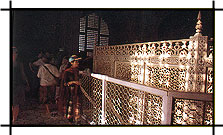
The
interior of the mausoleum comprises a lofty central chamber, a crypt immediately
below this and four octagonal corner rooms originally intended to house the
graves of other royal family members.
In the centre are the cenotaphs of Shah Jahan and Mumtaz Mahal. Shah Jahan's
cenotaph is to the left and is higher than that of his beloved which rests immediately
below the dome.
The cenotaph of Mumtaz Mahal stands in the centre of the marble screen, it has
inscribed on it in Persian with texts from the Koran. The cenotaph of Mumtaz
has the single epitaph inscribed on it- "Marqad Munavvar Arjumand Bano
Begum Mukhatib bah Mumtaz Mahal Tanifiyat fer sanh 1040 Hijri" (Here lies
Arjumand Bano Begum called Mumtaz Mahal who di((d in 1040 A.H. or 1630 A.D.)
The cenotaph of Shah Jahan is inscribed in Persian- .'Marqad Mutahar Aali Hazrat
Firdaus Ashiyani Sahib-qiran Saani Shah Jahan Badshah taab surah sanh 1076 Hijri"
(The sacred sepulchre of his most exalted Majesty, dweller of Paradise, the
second lord of constellations, the king Shah Jahan, may his mausoleum ever flourish,
1076 A.H. (1666 A.D.).
Above the tombs is a Cairene lamp, the flame of which is supposed to never burn
out.
Marble screen of trelliswork surrounds the graves. Both tombs are exquisitely
inlaid with semiprecious stones.
The acoustics of the building are superb with the domed ceiling being designed
to echo chants from Koran and musician's melodies.
It is suggested that one walk around the outside of the tomb, before retrieving
your shoes, to appreciate it from all sides.